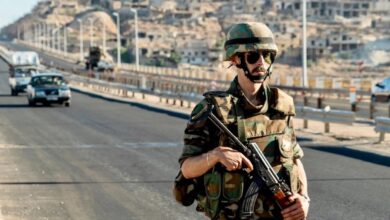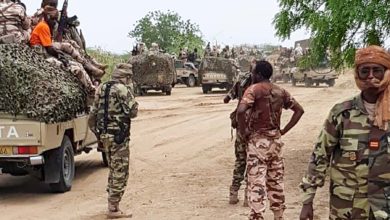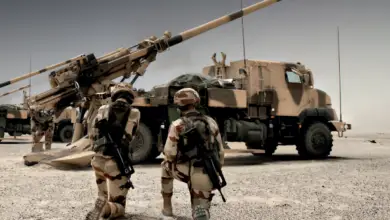A French solider was seriously injured during a counter-Islamic State operation near Indelimane in Mali’s Menaka region in which five ‘terrorists’ were ‘put out of action,’ the French Armed Forces Ministry said in a Monday, November 18 release.
In the early morning of November 16, during a “reconnaissance action conducted in the heart of the Malian Liptako” where Islamic state in the Greater Sahara is evolving, “the Barkhane force put five terrorists out of action in the Indelimane area,” the release said.
“Following the observation of movements of armed terrorist groups in the Liptako, an operation of opportunity was triggered against a suspicious camp” around 20 km south of Indelimane, also rendered as In Delimane.

“After being dropped off by helicopter, Barkhane force commandos infiltrated through difficult terrain at night,” the release said. “In the early morning, an assault was conducted with the support of Tigre helicopters from the Desert Aerocombat Battle Group, leading to the terrorists being put out of action.”
During the action, one commando was seriously injured. He was evacuated and then repatriated to France and is currently being cared for at Percy Military Hospital, the release said.
Four motorcycles, AK-47-type weapons, and other materiel including explosives, magazines and bullet-proof vests were seized or destroyed during the operation, the release said.
ISIS claimed two significant attacks in the Indelimane area of Mali earlier this month. It said its fighters were responsible for an attack on a military base in Indelimane that killed at least 49 people, and for a roadside bomb blast that killed a French soldier between Gao and Menaka the following day. ISIS said that attack was also in the Indelimane area.
Since May, ISIS has attributed insurgent activities in the Mali-Burkina Faso-Niger tri-border area to its West Africa Province affiliate, rather than to what was previously known as Islamic State in the Greater Sahara.
The news of the operation came just one day after the end of an ‘unprecedented’ 17-day joint counter-terror operation involving forces from France, Burkina Faso, Mali and Niger in the Déou area of Burkina Faso and Boulikessi area of Mali. More than 1,400 soldiers took part in the operation against “armed terrorist groups” and Operation Bourgou IV “resulted in 24 individuals being put out of action,” the French Armed Forces Ministry said.
Upsurge in Sahel violence
In 2012 a Tuareg separatist uprising against the state was exploited by Islamist extremists linked to al-Qaeda who took key cities in Mali’s desert north.
France began its Operation Serval military intervention in its former colony early the next year, driving the jihadists from the towns, and the MINUSMA peacekeeping force was then established.
But the militant groups have morphed into more nimble formations operating in rural areas, and the insurgency has gradually spread to central and southern regions of Mali and across the borders into neighboring Burkina Faso and Niger. Large swathes of Mali remain outside government control, and inter-ethnic bloodshed is a regular occurrence.
The majority of attacks in the Sahel are attributed to JNIM, which formed in March 2017 from a merger of several smaller groups including the Sahara branch of al-Qaeda in the Islamic Maghreb, Ansar Dine and al-Mourabitoun. JNIM’s leadership has pledged allegiance to al-Qaeda leader Ayman al-Zawahiri.
The U.N. says that since January more than 1,500 civilians have been killed in Burkina Faso and Mali, and more than one million people have been internally displaced across the five Sahel states – more than twice the number displaced in 2018. Access has become increasingly difficult, but 12 million people are in need of humanitarian assistance.
The Serval mission evolved in August 2014 into Operation Barkhane, and roughly 4,500 French troops are deployed in the region, including around 2,700 soldiers in Mali. Barkhane has a growing international dimension, with European partners sending more troops and equipment. Denmark is to send two helicopters and up to 70 troops to support Barkhane in December and Estonia is to almost double the size of its Barkhane contingent in 2020. Chinook helicopters from the United Kingdom currently support the operation.
Operation Barkhane focuses activity in insurgent-hit Mali, Niger and Burkina Faso, and troops work alongside other international operations, including the 14,000-strong MINUSMA U.N. stabilization mission in Mali and the G5 Sahel Joint Force (FCG5S), a planned 4,500-strong joint counter-terrorism force comprising troops from Burkina Faso, Chad, Mali, Niger and Mauritania.
France has also been trying to build international support for a new military force to work alongside Barkhane.
French plans for a new international special operations task force for the Sahel were first reported in early October, and on November 5, Armed Forces Minister Florence Parly said that France expected the new force – dubbed “Takuba” – to deploy in Mali by 2020. Around a dozen European states “have expressed an interest in taking part in this initiative,” a French Armed Forces spokesperson said.
Estonia is the first partner to confirm a special operations forces deployment to Takuba. A defense ministry spokesperson told The Defense Post that special forces will deploy to Mali in the second half of 2020 and that force will ‘assist, advise and accompany’ the Malian Armed Forces.
Last week, senior officials said the United States is seeking a meeting of the Coalition against ISIS early in 2020 to focus on threats in West Africa and the Sahel.
Estonia special forces to join France-led Takuba mission in Mali, defense ministry says












